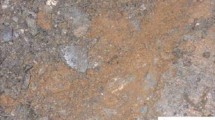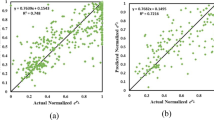Abstract
The determination of liquefaction potential of soil is an imperative task in earthquake geotechnical engineering. The current research aims at proposing least square support vector machine (LSSVM) and relevance vector machine (RVM) as novel classification techniques for the determination of liquefaction potential of soil from actual standard penetration test (SPT) data. The LSSVM is a statistical learning method that has a self-contained basis of statistical learning theory and excellent learning performance. RVM is based on a Bayesian formulation. It can generalize well and provide inferences at low computational cost. Both models give probabilistic output. A comparative study has been also done between developed two models and artificial neural network model. The study shows that RVM is the best model for the prediction of liquefaction potential of soil is based on SPT data.


Similar content being viewed by others
References
Christian JT, Swiger WF (1975) Statistics of liquefaction and SPT results. J Geotech Eng 101(11):1135–1150
Ferreira LV, Kaszkurewicz E, Bhaya A (2005) Solving systems of linear equations via gradient systems with discontinuous righthand sides: application to LS-SVM. IEEE Trans Neural Netw 16(2):501–505
Fletcher R (1987) Practical methods of optimization. Wiley, Chichester, New York
Goh ATC (1994) Seismic liquefaction potential assessed by neural networks. J Geotech Eng 120(9):1467–1480
Haldar A, Tang WH (1979) Probabilistic evaluation of liquefaction potential. J Geotech Eng 104(2):145–162
Kecman V (2001) Learning and soft computing: support vector machines, neural networks, and fuzzy logic models., The MIT press, Cambridge, Massachusetts, London, England
Lai SY, Chang WJ, Ping-Sien Lin PS (2006) Logistic regression model for evaluating soil liquefaction probability using CPT data. J Geotech Geoenviron Eng 132(6):694–704
Liao SSC, Veneziano D, Whitman RV (1988) Regression models for evaluating liquefaction probability. J Geotech Eng 114(4):389–411
Lu C, Gestel TV, Suykens JAK, Huffel SV, Vergote I, Timmerman D (2003) Preoperative prediction of malignancy of ovarian tumors using least squares support vector machines. Artif Intell Med 28(3):281–306
MacKay DJ (1994) Bayesian methods for backpropagation networks, in models of neural networks III. Springer, New York
MathWork Inc (1999) Matlab user’s manual. Version 5.3. The MathWorks Inc, Natick, MA
Neal R (1994) Bayesian learning for neural networks. Ph.D thesis, University of Toronto, Toronto, Quebe, Canada
Park D, Rilett LR (1999) Forecasting freeway link ravel times with a multi-layer feed forward neural network. Comput Aided Civil Infra Struct Eng 14:358–367
Samui P (2007) Seismic liquefaction potential assessed by relevance vector machine. J Earthquake Eng Eng Vib 6(4):331–336
Seed HB, Idriss IM (1967) Analysis of soil liquefaction: Niigata earthquake. J Soil Mech Found Div ASCE 93(3):83–108
Seed HB, Idriss IM (1971) Simplified procedure for evaluating soil liquefaction potential. J Soil Mech Found Div ASCE 97(9):1249–1273
Seed HB, Idriss IM, Arango I (1983) Evaluation of liquefaction potential using field performance data. J Geotech Eng Div ASCE 109(3):458–482
Seed HB, Tokimatsu K, Harder LF, Chung RM (1984) Influence of SPT procedures in soil liquefaction resistance evaluation. Rep. No. UCB/EERC-84/15, Earthquake Engineering Research Center, University of California, Berkeley, Calif
Sincero AP (2003) Predicting mixing power using artificial neural network. EWRI World Water and Environmental
Suykens JAK, Vandewalle J (1999) Least squares support vector machine classifiers. Neural Process Lett 9(3):293–300
Suykens JAK, Lukas L, Dooren PV, Moor BD, Vandewalle J (1999) Least squares support vector machine classifiers: a large scale algorithm. In Proceedings of the European conference on circuit theory and design (ECCTD’99), Stresa, Italy, pp 839–842
Suykens JAK, Gestel TV, Brabanter JD, Moor BD, Vandewalle J (2002) Least squares support vector machines. World Scientific Publishing, Singapore
Tipping ME (2000) The relevance vector machine. Adv Neural Inf Process Syst 12:625–658
Tipping ME (2001) Sparse Bayesian learning and the relevance vector machine. J Mach Learn 1:211–244
Author information
Authors and Affiliations
Corresponding author
Rights and permissions
About this article
Cite this article
Samui, P. Least square support vector machine and relevance vector machine for evaluating seismic liquefaction potential using SPT. Nat Hazards 59, 811–822 (2011). https://doi.org/10.1007/s11069-011-9797-5
Received:
Accepted:
Published:
Issue Date:
DOI: https://doi.org/10.1007/s11069-011-9797-5




